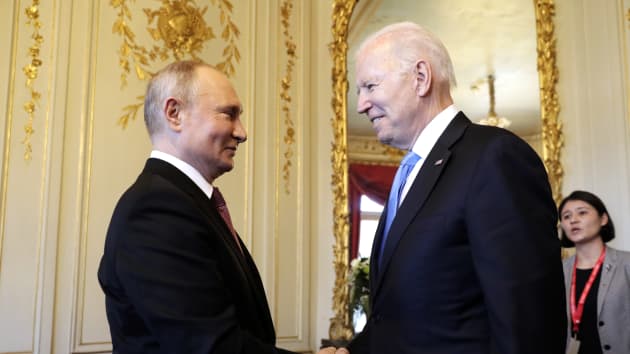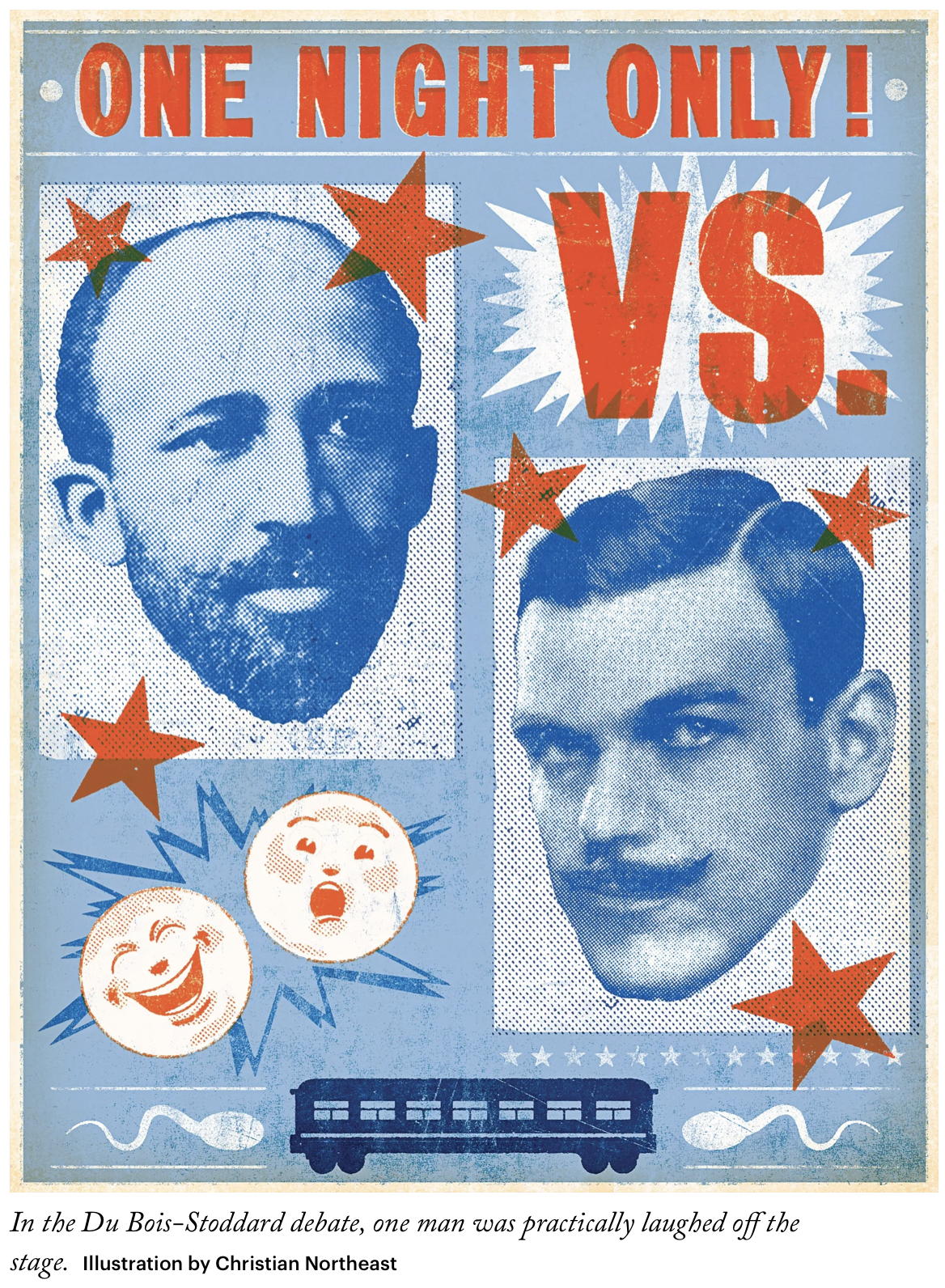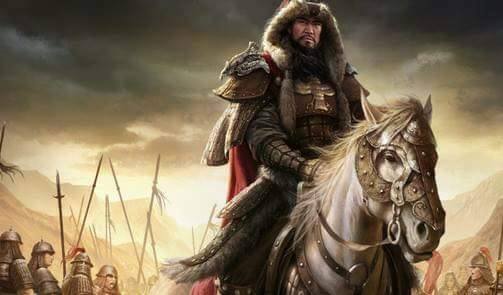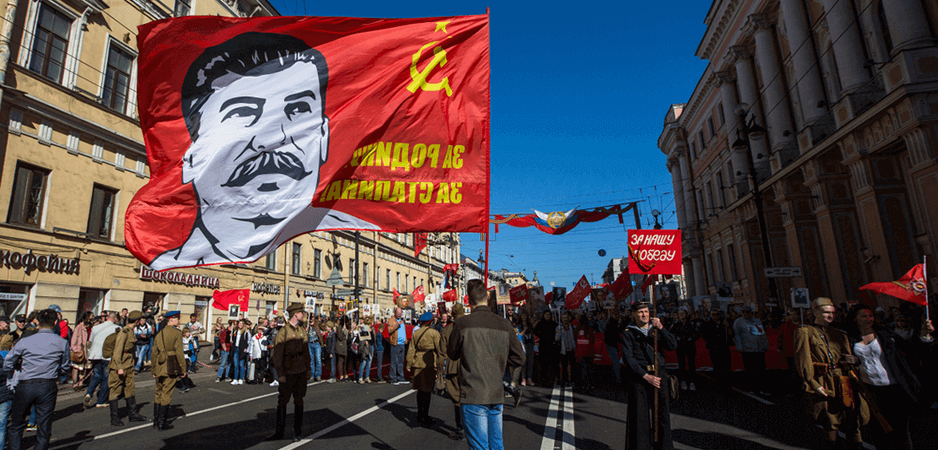
K. Philippe Gendrault

The Putin-Biden Summit in Geneva did not—could not—dismantle the huge US establishment investment in Russsophobia.
As the press and the media claim, the relationship between the United States and Russia is particularly tense, even at a time when J. Biden just met with V. Putin. Russia, Russia, Russia. The United States continues to be literally obsessed with that country. Notwithstanding the new cold war with China, Russia keeps on being the target of American wrath, fears and anxieties. Seemingly underhanded, prone to cyberterrorism, constantly challenging and interfering in American affairs, both domestic and abroad, Russia, if one listens to the mainstream media, persists in remaining a thorn in “democracy’s” side.
Of course, at the mere mention of Russia, most will associate the Soviet bear and the [putative] moral corruption its communist ideology unleashed onto the benevolent, peace-loving and freedom-loving world, i.e., Western social-democracies with the US at the helm. In light of the fact that the Russian Federation is no longer socialist, one might ponder why the United States and Europe carry on this veritable cold war obsession with Russia.
Recently, J. Biden answered in the positive whether V. Putin was a killer. A reporter for the Atlantic stated, “I looked into his [Putin] eyes once, and what I saw scared me half to death” (The Atlantic, 03/02/14). H. Clinton stated that “Putin does not have a soul” (Politico, 01/06/08), which was echoed by J. Biden in 2011 who is claimed to have told the Russian leader, “Mr. Prime Minister, I am looking into your eyes, and I don’t think you have a soul” (The Hill, 07/21/14). Whereas G. W. Bush felt able to see V. Putin’s soul in a more or less positive fashion, when asked if he saw what Bush saw, Obama stated, “I looked the man (Putin) in the eyes and saw… the enemy” (Dallas Morning Post, 06/29/10).

The Russian revolution Stoddard asserts, “set revolutionists everywhere aquiver, firing their blood, inflaming their “will to power,” and nerving their hearts to victory.” But, Stoddard explains, Russia was more susceptible to revolutionary ardor because of its atavism, “its veneers of civilization laid thinly over instinctive wildness and refractory barbarism.”
One could certainly wonder why so many people seem so keen on gazing into the Russian leader’s eyes and more particularly why they assume this will inform them on the man’s character and particularly on geopolitical relations between the Russian Federation and the United States. The concern for his soul or rather the concern to figure out whether he has a soul or not appears to be no less important in US politics… This is reminiscent of a controversy (2018) surrounding the death penalty case of a Black individual that occurred when one of the jurors, a certain B. Gattie, expressed his views claiming, “After studying the Bible, I have wondered if Black people even have souls” (Newsweek, 2/22/19). Seemingly, the enemy is soulless.
Russians or should I say the “Russian soul” clearly remain some mysterious object to the American public and politicians of this country. What of Russians? What is it about the Russian people that triggers this, let’s call it what it is, primitive and paranoid reaction whereas all rationality disappears leading parents and children alike to run to the metaphorical shelter, shouting “people beware, the Russians are coming?”
Russophobia is usually defined by the Collins dictionary as follows, an intense hatred and often irrational hatred for Russia, or especially the former Soviet Union. While the first known use of the term “Russophobia” occurred in 1836, Russophobia, usually associated with the USSR, has been burning red hot well before the Russian revolution of 1917, in France with the Myth of Eastern Despotism, in Great Britain with the Threat of the Russian Empire, in Germany where cosmopolitan Russia represented the antithesis of the Prussian State and finally in the United States who carried on where the French, the English and the Germans left off (Creating Russophobia, Clarity Press, 2017). One cannot escape but notice that Russia was already a “threat” to the great western imperial and colonial powers well before it became socialist.

Poster publicizing the Du Bois-Stoddard debate.
Of course, the Nazi ideological handling of populations of Eastern Europe is sadly well known and is associated with the extermination of Poles and Russians (Nazi colonial project – Generalplan Ost) deemed racially inferior ethnic groups under the label of Untermensch (Subhuman or Under-man). But the notion of Untermensch so appreciated by the Nazis is not a German invention. The term, with its racial connotation, was born from the mind of the Harvard historian and Ku Klux Klan member Lothrop Stoddard and expressed in his book, The revolt of Civilization: The Menace of The Under-man published in 1922; the very man whom W. E. B. Dubois debated and ridiculed in a famous encounter in Chicago in 1929.
To really understand the roots of Russophobia, we must delve into the white supremacist, racialist, fascist and anti-communist mythology constructed about Russians in the 20s, which we will hypothesize persists to this day. The ideological foundation of Russophobia is the very same as the one of anticommunism and anti-Blackness; although the white supremacist will ask, are Russians white people?
For the sake of clarity, we will use all the terms used by white supremacist and fascist authors in order to not whitewash or moderate the obvious and patent racism of their ideology.
In a text published in 1920, The Rising Tide of Color Against White World-Supremacy, for L. Stoddard, the racial impoverishment of Russia started with the eviction of Nordic populations from their homes. Stoddard claims that Nordic lands, including Russia, after the fall of Rome, were overtaken by Slavs and Wends in consequence to Mongoloid pressure. On top of the partial occupation of Russia by Slavs and the elimination of Nordic populations, a series of Mongoloid invasions transformed the racial landscape of Russian lands. Thus, the various populations of Russia and the Balkans underwent the influence of Asiatic, Tatar and Mongoloid settlements. For Stoddard, the whole land suffered the barbarism of the hordes of the East. In this text, Stoddard does answer the question whether Russians are white or not. If he precises that in more recent history, Russia became once again more Nordicized, i.e., white, through the rise of a Russian Nobility originating in the Baltic region, he also clearly asserted that in the rest of the country, through Bolshevism, the half-Asiatic peasantry of Russia became dominant. Thereby, Russians are semi-Asian, whatever that means.

The perennial Russian threat in the mind of too many reactionary white supremacists.
Later on, Stoddard, in the text mentioned earlier Revolt of Civilization, attributed the revolutionary unrest in Russia not so much to Bolshevik propaganda or to prior historical events [and legitimate causes] but principally to what this racial impoverishment implied. Accordingly, Russians were more primitive than Western Europeans, and reverted easily to their “animal instincts.” This author follows up analyses of the literary giant Tolstoy who finds himself accused of having an “instinctive aversion to civilization.” Stoddard writes, “The first wild impulse which Tolstoy felt when he saw a building, or any complex whole, created by the hand of man, was to simplify, to level, to crush, to destroy, so that the stone might be left upon the other and the place might again become wild and simple and purified from the work of man’s hand.” Russians accordingly wish to simplify complexity and to destroy culture. In light of this critique of the Russian writer, Stoddard concludes that the Russian people are “made up chiefly of primitive racial strains, some of which (especially the Tatars and other Asiatic nomad elements) are distinctly “wild” stocks which have always shown an instinctive hostility to civilization.” Communism is thrown into the lot and becomes reduced to an ‘Instinctive reaction against the attempt to civilize Russia begun by Peter the Great…” The whole Russian people resist the civilizing endeavor of Westernization. Russians thereby are prone to revolutionary reactions against civilization. The embrace of communism is only a symptom of their racial inferiority. These primitive hordes have “converted Russia into a vacant level plan” and threatened to do the same with Europe and the whole world. The establishment of socialism can be attributed to the strength of the forces of chaos and the rise in criminality, hooliganism, characteristic of the Russian races. Stoddard emphasizes:
forms but essentially the same, and ever broadening and deepening until it has become the veritable flood which has submerged Russia and which threatens to engulf our entire civilization. Its most noteworthy achievement has been the working out of a revolutionary philosophy and propaganda so insidiously persuasive as to wield together many innately diverse elements into a common league of discontent…”
Furthering his analysis of this offensive tide, Stoddard focused his attention on unionism, in which he saw, “…For the first time in human history a full-fledged philosophy of the Under-man – prologue of that vast revolt against civilization which, with Russian Bolshevism, has actually begun.” For L. Stoddard, these movements of discontent, “Syndicalists in France, Bolshevists in Russia, I.W.W.’s in America” united against civilization as a whole; …” One army, enlisted for a single war.” A war, which he called, “of the hand against the brain.” The underworld of Under-men, according to him, wants to destroy the world for “under-men despise thought itself… Their guide is, not reason, but the ‘proletarian truth’ of instinct and passion.” The whole Russian character, for this fascist writer, is fundamentally primitive, criminal, instinctual, violent, irrational and un-intellectual. Such accusations thrown at the Russian enemy of “white civilization” are clearly not unique and reveal the stereotypical aspect of these racist “analyses” of all so-called non-white or poor “uncivilized populations,” not least of which, the African populations in the Americas and colonies on the African continent.
The Russian revolution Stoddard asserts, “set revolutionists everywhere aquiver, firing their blood, inflaming their “will to power,” and nerving their hearts to victory.” But, Stoddard explains, Russia was more susceptible to revolutionary ardor because of its atavism, “its veneers of civilization laid thinly over instinctive wildness and refractory barbarism.” From claiming to Russian race inferiority, Stoddard continues a relentless assault on socialist endeavors and its leadership, constituted according to him, mostly of unstable individuals, “’tainted geniuses,’ paranoiacs, unbalanced fanatics, unscrupulous adventurers, clever criminals, etc.” The Russian under-man has therefore succeeded in eliminating the racially superior elements of society, namely Nordic aristocrats, Czarist intellectuals, and the bourgeoisie, sole redemptors of barbarian Slavs.
In this latter text, Stoddard particularly emphasized the inferiority of Russians by proclaiming that their adherence to Bolshevism, socialism and equality reveals such inferiority, counter to the “natural” order of racial inequalities. The association between Russian racial inferiority and communism imposed by the white supremacist writer is not unlike that found between anti-blackness and anti-communism (Burden-Stelley, Left Voice, 2017) as mentioned above. And these racial considerations find their ways into national American politics. Particularly, the anxiety around the issue of the “Russian race’, which did have an impact on US policies of immigration as shown by a report of the US Senate’s Immigration Commission in 1910 (J. S. Roucek, 1969).
Slavs (Sclave), Slavic or Slavonic; sometimes wrongly called in the United States “Hun” (see Magyar). To be defined as that Aryan “race” or linguistic group which occupies the greater part of Russia and the Balkans. The Russians and the Polish (see) are its leading tongues. The Slavic, the Teutonic, and the Italian or Latin are the three great stocks that furnish the most of the population of Europe as well as our annual flood of immigrants. Of these three, the Slavic and the Italic have been greatly replacing the Teutonic in American immigration, and the Slavic is perhaps the most significant for the future because of its great population.
Physically, and perhaps temperamentally, the Slavs approach the Asiatic or particularly the Tatar, more closely than do the peoples of Western Europe. In language, they are as truly Aryan as ourselves. There is some truth in the old saying, “Scratch a Russian and you find a Tatar,” especially if he comes from Southern Russia, where once lived the Mongol conquerors of the Russians… If the Slav is still backward in Western ideas, appliances, and form of government, it is not far distant when he will stand in the lead. The race is still young…”
J. S. Roucek notes that this report stood as one of the most important factors contributing to the Immigration Quota Act of 1924.
In the American psyche, the Russian was and remains a confusing character consequent to the uncertainty of his or her location in the racist, white supremacist landscape; European in language but Asian in “blood,” leaving the Russian character as mal-formed and threatening in the racist mind.
Primitive, uncivilized, antisocial, destructive, criminal, mentally and intellectually challenged, the Russian like the Black man comes to represent the incarnation of all the anxieties, persecutory and paranoid projections of white supremacy onto others. In any event, the Russian character is not trustworthy. The integration of such “racial barbarism” with socialist ideas carried by the lower classes altogether furthers the rationalization of all white supremacist, fascist, capitalist, conservative and reactionary beliefs, namely, the Russians are dangerous… no matter what.
A French fascist and white supremacist, François Coty introduced his 1931 text, Sauvons Nos Colonies (Let Us Save Our Colonies), with the exact same ideological prejudices but in the French colonial context. He stated in the book’s preamble,
It is the destiny of Asia to periodically rush to the conquest of Europe and to set about its destruction. This is like some mystical call that Barbarians can’t resist: they hear, generation after generation, the whispering voice of Genseric calling him to ransack Rome.
In the Vth century, the Huns overthrowing dozens of people and taking them in tow, already aspired to leave no stones standing in Occidental cities, and bragged that grass would never grow again in places they had been through. In the XIIth century, the rush started again with Genghis Khan’s Mongols who left an indelible Asian footprint on Russia. Not particularly curious about the yellow soul, westerners generally ignore that memories of the great invasions of past are still today the topics of conversation of Mongoloid races and those arouse in them the hope for invasions anew.
Bolshevism, twice Asiatic, through its original conception of Hebraic theories and through the recruiting of its most dangerous followers who mostly belong to mongoloid people of Russia, has come to crystalize all the hopes of the yellow race and to have it understand that the time had come. From the Urals to the depth of Siberia, A great chill of excitement overcame the destructive hordes of yesterday.
The first manifestations of these Asian warriors’ awakening against Europe, have naturally occurred in the colonies created by the white race on the Asian land itself. It is there that inevitably the first convulsions would appear, allowing the Yellow Man to take his revenge on the Westerner. The testimony of the Mongol Lenin, of pure Chuvash blood [Note, Chuvash are today known to be Turkic and not Mongol], claimed among other things, the necessity of throwing Europeans out of Asia.
Not only would Asian forces increase in this final conflict but European nations would come out of this victorious insurrection in their Asian colonies demoralized, uncertain of their ethnic superiority and materially poorer with the loss of hundreds of billions invested in their possessions. The Assault on Europe would follow.
We propose to study in our next book how Lenin’s program is already activated in Asia with the undermining of European domination, with the progressive conquest by Yellows, led by Bolshevism, and with the undermining of the moral ascendency of whites. […] But the threat in Asia is not all. The world has changed since Attila and Genghis Khan and Asia benefits, at the expense of Europe, from the inventions and progresses, which Europe itself has achieved for centuries. […] The most modern discoveries like the radio are used by Bolshevist propaganda, as efficaciously as the ancient forces of darkness still holding in some corner of the globe, like negro witchcraft. Revolutionary syndicalism, popularized among Negroes, Yellows as well as Whites is the vehicle of the Revolution under any climate. In the face of this rising tide, menacing with all sorts of perils the future of our race, the only one to which the world owes its moral, intellectual and material progress…
From the white supremacist and fascist perspective, the “Russian” may appear white, may speak an Aryan language “like ours” but he or she is not white. Behind Russians lurks the invading Mongolian Hordes, the savage Asiatic warriors, primitive destroyers of civilization. But alongside the Russian and all his “mongoloid associates”, we might include the Chinese who because of such primitiveness, have embraced the savagery of socialism and communism. To echo the parallel between anti-blackness and anticommunism explained by C. Burden-Stelley (2017), these white supremacists and fascists writings reveal how the assumed inferior racial status, of itself, suffices to explain the “passions” for unionism and communism and reciprocally, how unionism and communism come to be embraced by people because they are of inferior racial standing. Racial inferiority and communism become one and the same.

Those recalcitrant Russians: Carrying a Stalin banner in a 2018 St. Petersburg demonstration
Therefore, within the logic of this white supremacist and fascist ideology, Racism and Anticommunism become both indices of civilization, of racial and cultural superiority, and of social order, a system of beliefs embedded to this day in the Euro-American bourgeois social self-representation. For this Euro-American ideological structuring of social order, steeped in this white supremacist and fascist ideology; the challenge has been to attempt separating racism from anti-communism, which liberals still today persist in trying to achieve, i.e., to uphold anti-communism while lessening racism, clearly to no avail…
Even though these “scientific racial theories” have been debunked, scientifically as well as politically, we contend that this white supremacy and fascist ideology, expressed blatantly through the systemic racism prevalent in capitalist systems, still frames the imaginary blueprint of American culture when it comes to Russian culture with its Asian connotation.
The fantasy of facing a Russian, Chinese or North Korean invasion, as portrayed by Hollywood vehicles like Red Dawn, stand as modern versions of the “Mongoloid hordes” of yesterday, imaginary scripts speaking more loudly and accurately of the invaded than the invaders. As we can observe, these fears and anxieties, framed through the template of Russophobic white supremacist ideology, remain as powerful today as they were then, so much that they can easily and readily be mobilized to fuel the popular sentiment against Russia, China or both since behind every Russian lurks some primitive Asian threat, and behind them all lurks some communist insurgency.
From Russiagate to the Wuhan virus, the blueprint of hatred for all things Russian (and Chinese by extension) has already been processed and ready for use a hundred years ago, and to this day, the American population remains psychosocially primed to take on this soulless enemy, the destroyer of civilization whenever the white supremacist and fascist finger of the bourgeoisie points at that enemy… be it contemporary Russia or socialist China, or, as noted, both.
 K. Philippe Gendrault
K. Philippe Gendrault, Ph.D., is a clinical psychologist and psychoanalyst committed to the anti-racist, anti-imperialist struggle for social and political justice.

All image captions, pull quotes, appendices, etc. by the editors not the authors.
YOU ARE FREE TO REPRODUCE THIS ARTICLE PROVIDED YOU GIVE PROPER CREDIT TO THE GREANVILLE POST
VIA A BACK LIVE LINK.
 This work is licensed under a Creative Commons Attribution-NonCommercial 4.0 International License
This work is licensed under a Creative Commons Attribution-NonCommercial 4.0 International License

[premium_newsticker id="211406"]
Don't forget to sign up for our FREE bulletin. Get The Greanville Post in your mailbox every few days.
[newsletter_form]
 The Grayzone's Max Blumenthal tries to confront the vile Adam Schiff, "Mr Russiagate", as Schiff cynically seeks a photo op at an anti-eviction rally in DC, but Schiff chooses to ignore him (the wiser course since he has literally no legitimate defense for what he does and relies on a whore media system to maintain his power platforms.) Unfortunately, the duopoly abounds in sociopathic crooks like Schiff.
The Grayzone's Max Blumenthal tries to confront the vile Adam Schiff, "Mr Russiagate", as Schiff cynically seeks a photo op at an anti-eviction rally in DC, but Schiff chooses to ignore him (the wiser course since he has literally no legitimate defense for what he does and relies on a whore media system to maintain his power platforms.) Unfortunately, the duopoly abounds in sociopathic crooks like Schiff.

















